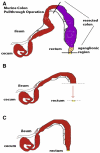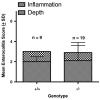Murine model of Hirschsprung-associated enterocolitis II: Surgical correction of aganglionosis does not eliminate enterocolitis
- PMID: 20105605
- PMCID: PMC4375950
- DOI: 10.1016/j.jpedsurg.2009.10.035
Murine model of Hirschsprung-associated enterocolitis II: Surgical correction of aganglionosis does not eliminate enterocolitis
Abstract
Background: Hirschsprung disease (HD) results from aganglionosis of the colon, is linked to acute and chronic enterocolitis (known as Hirschsprung-associated enterocolitis) despite successful corrective surgery, and can lead to bacteremia and even death. The genetic and molecular mechanisms underlying these disorders are largely unknown.
Methods: We developed a microsurgical corrective pull-through procedure in mice, and applied that to Ednrb(-/-) mice, which manifest aganglionic megacolon that is very similar to HD. Wild-type littermates (Ednrb(+/+)) also underwent identical surgery. At prespecified time points postoperatively, mice were sacrificed, and histopathologic analyses of intestinal inflammation were performed. Mice of both genotypes were sacrificed after the postoperative recovery period to determine if corrective surgery itself caused inflammation. Stooling patterns were assessed as well to determine if intestinal function normalized after surgery.
Results: There was no difference in histopathological enterocolitis scores after recovery from surgery. Stooling patterns in Ednrb(-/-) and Ednrb(+/+) mice were similar postoperatively, suggesting normalization of intestinal function. However, with time, approximately 40% of Ednrb(-/-) mice developed clinical illness consistent with enterocolitis. No control (Ednrb(+/+)) mice developed clinical enterocolitis. Histopathological enterocolitis scores in the 40% of Ednrb(-/-) mice that developed clinical enterocolitis postoperatively were significantly worse than those of healthy postoperative Ednrb(-/-) mice. In contrast, none of the Ednrb(+/+) control mice exhibited postoperative long-term inflammation.
Conclusions: Microsurgical pull-through operation in Ednrb(-/-) mice produces a mouse model that closely resembles key features of Hirschsprung-associated enterocolitis, enabling controlled study of genetic and molecular mechanisms in Ednrb(-/-) mice and other genotypes that produce similar phenotypes.
Copyright 2010 Elsevier Inc. All rights reserved.
Figures






References
-
- Hosoda K, Hammer RE, Richardson JA, et al. Targeted and natural (piebald-lethal) mutations of endothelin-B receptor gene produce megacolon associated with spotted coat color in mice. Cell. 1994;79:1267–76. - PubMed
-
- Fujimoto T. Natural history and pathophysiology of enterocolitis in the piebald lethal mouse model of Hirschsprung's disease. J Pediatr Surg. 1988;23:237–42. - PubMed
-
- Fujimoto T, Reen DJ, Puri P. Inflammatory response in enterocolitis in the piebald lethal mouse model of Hirschsprung's disease. Pediatr Res. 1988;24:152–5. - PubMed
Publication types
MeSH terms
Grants and funding
LinkOut - more resources
Full Text Sources
Other Literature Sources

